2016 NISSAN LEAF sensor
[x] Cancel search: sensorPage 323 of 437
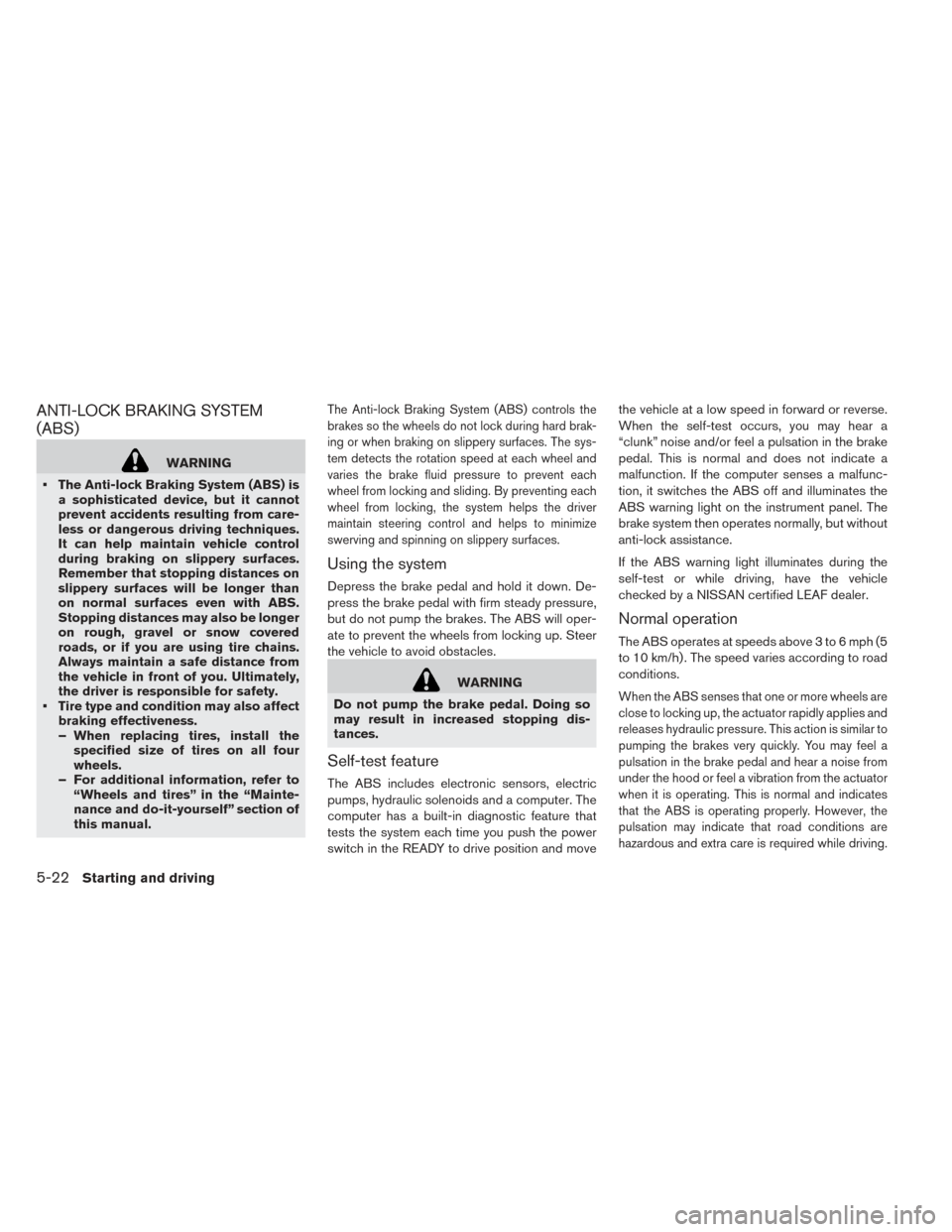
ANTI-LOCK BRAKING SYSTEM
(ABS)
WARNING
• The Anti-lock Braking System (ABS) is a sophisticated device, but it cannot
prevent accidents resulting from care-
less or dangerous driving techniques.
It can help maintain vehicle control
during braking on slippery surfaces.
Remember that stopping distances on
slippery surfaces will be longer than
on normal surfaces even with ABS.
Stopping distances may also be longer
on rough, gravel or snow covered
roads, or if you are using tire chains.
Always maintain a safe distance from
the vehicle in front of you. Ultimately,
the driver is responsible for safety.
• Tire type and condition may also affect braking effectiveness.
– When replacing tires, install thespecified size of tires on all four
wheels.
– For additional information, refer to “Wheels and tires” in the “Mainte-
nance and do-it-yourself” section of
this manual.
The Anti-lock Braking System (ABS) controls the
brakes so the wheels do not lock during hard brak-
ing or when braking on slippery surfaces. The sys-
tem detects the rotation speed at each wheel and
varies the brake fluid pressure to prevent each
wheel from locking and sliding. By preventing each
wheel from locking, the system helps the driver
maintain steering control and helps to minimize
swerving and spinning on slippery surfaces.
Using the system
Depress the brake pedal and hold it down. De-
press the brake pedal with firm steady pressure,
but do not pump the brakes. The ABS will oper-
ate to prevent the wheels from locking up. Steer
the vehicle to avoid obstacles.
WARNING
Do not pump the brake pedal. Doing so
may result in increased stopping dis-
tances.
Self-test feature
The ABS includes electronic sensors, electric
pumps, hydraulic solenoids and a computer. The
computer has a built-in diagnostic feature that
tests the system each time you push the power
switch in the READY to drive position and move the vehicle at a low speed in forward or reverse.
When the self-test occurs, you may hear a
“clunk” noise and/or feel a pulsation in the brake
pedal. This is normal and does not indicate a
malfunction. If the computer senses a malfunc-
tion, it switches the ABS off and illuminates the
ABS warning light on the instrument panel. The
brake system then operates normally, but without
anti-lock assistance.
If the ABS warning light illuminates during the
self-test or while driving, have the vehicle
checked by a NISSAN certified LEAF dealer.
Normal operation
The ABS operates at speeds above 3 to 6 mph (5
to 10 km/h) . The speed varies according to road
conditions.
When the ABS senses that one or more wheels are
close to locking up, the actuator rapidly applies and
releases hydraulic pressure. This action is similar to
pumping the brakes very quickly. You may feel a
pulsation in the brake pedal and hear a noise from
under the hood or feel a vibration from the actuator
when it is operating. This is normal and indicates
that the ABS is operating properly. However, the
pulsation may indicate that road conditions are
hazardous and extra care is required while driving.
5-22Starting and driving
Page 324 of 437
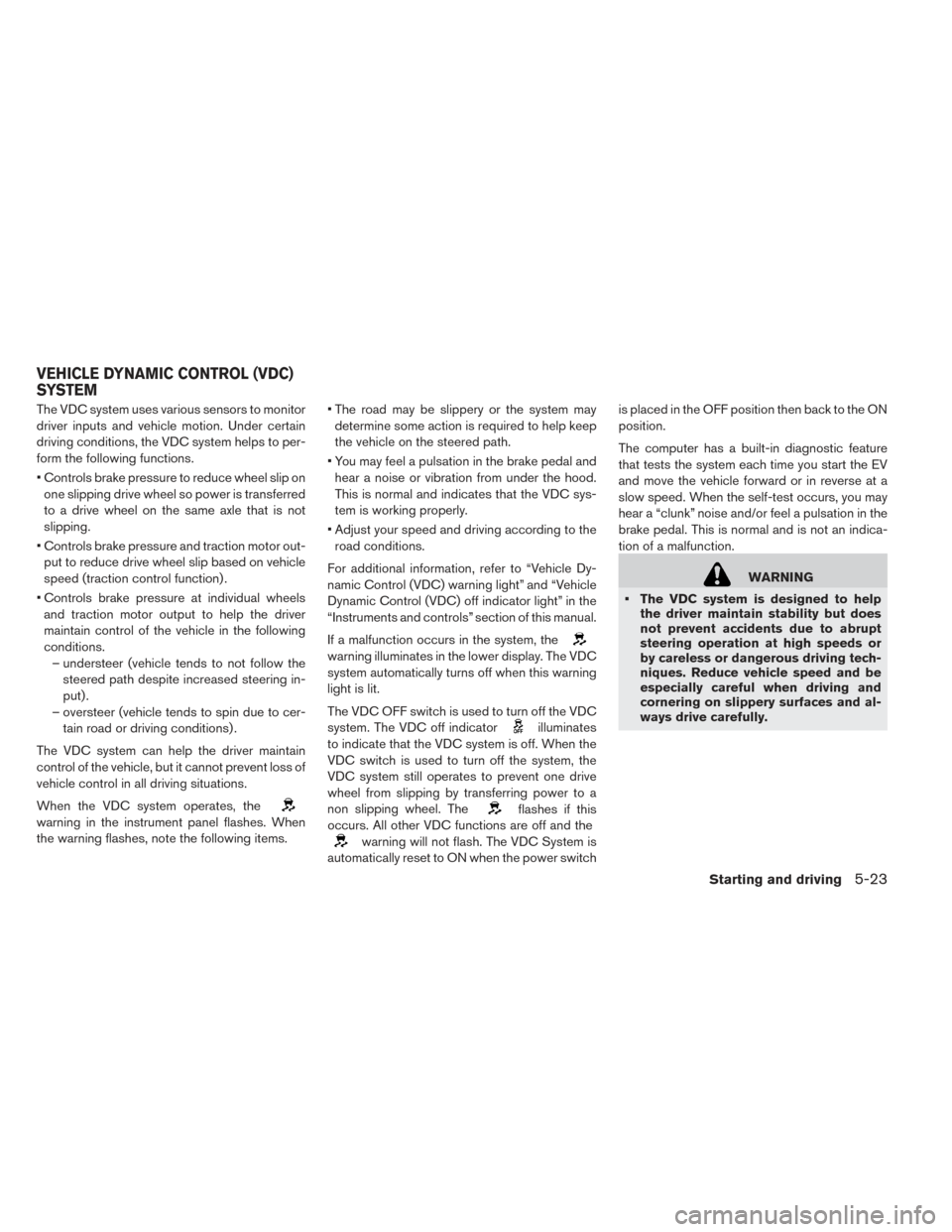
The VDC system uses various sensors to monitor
driver inputs and vehicle motion. Under certain
driving conditions, the VDC system helps to per-
form the following functions.
• Controls brake pressure to reduce wheel slip onone slipping drive wheel so power is transferred
to a drive wheel on the same axle that is not
slipping.
• Controls brake pressure and traction motor out- put to reduce drive wheel slip based on vehicle
speed (traction control function) .
• Controls brake pressure at individual wheels and traction motor output to help the driver
maintain control of the vehicle in the following
conditions. – understeer (vehicle tends to not follow the steered path despite increased steering in-
put) .
– oversteer (vehicle tends to spin due to cer- tain road or driving conditions) .
The VDC system can help the driver maintain
control of the vehicle, but it cannot prevent loss of
vehicle control in all driving situations.
When the VDC system operates, the
warning in the instrument panel flashes. When
the warning flashes, note the following items. • The road may be slippery or the system may
determine some action is required to help keep
the vehicle on the steered path.
• You may feel a pulsation in the brake pedal and hear a noise or vibration from under the hood.
This is normal and indicates that the VDC sys-
tem is working properly.
• Adjust your speed and driving according to the road conditions.
For additional information, refer to “Vehicle Dy-
namic Control (VDC) warning light” and “Vehicle
Dynamic Control (VDC) off indicator light” in the
“Instruments and controls” section of this manual.
If a malfunction occurs in the system, the
warning illuminates in the lower display. The VDC
system automatically turns off when this warning
light is lit.
The VDC OFF switch is used to turn off the VDC
system. The VDC off indicator
illuminates
to indicate that the VDC system is off. When the
VDC switch is used to turn off the system, the
VDC system still operates to prevent one drive
wheel from slipping by transferring power to a
non slipping wheel. The
flashes if this
occurs. All other VDC functions are off and the
warning will not flash. The VDC System is
automatically reset to ON when the power switch is placed in the OFF position then back to the ON
position.
The computer has a built-in diagnostic feature
that tests the system each time you start the EV
and move the vehicle forward or in reverse at a
slow speed. When the self-test occurs, you may
hear a “clunk” noise and/or feel a pulsation in the
brake pedal. This is normal and is not an indica-
tion of a malfunction.
WARNING
• The VDC system is designed to help the driver maintain stability but does
not prevent accidents due to abrupt
steering operation at high speeds or
by careless or dangerous driving tech-
niques. Reduce vehicle speed and be
especially careful when driving and
cornering on slippery surfaces and al-
ways drive carefully.
VEHICLE DYNAMIC CONTROL (VDC)
SYSTEM
Starting and driving5-23
Page 333 of 437
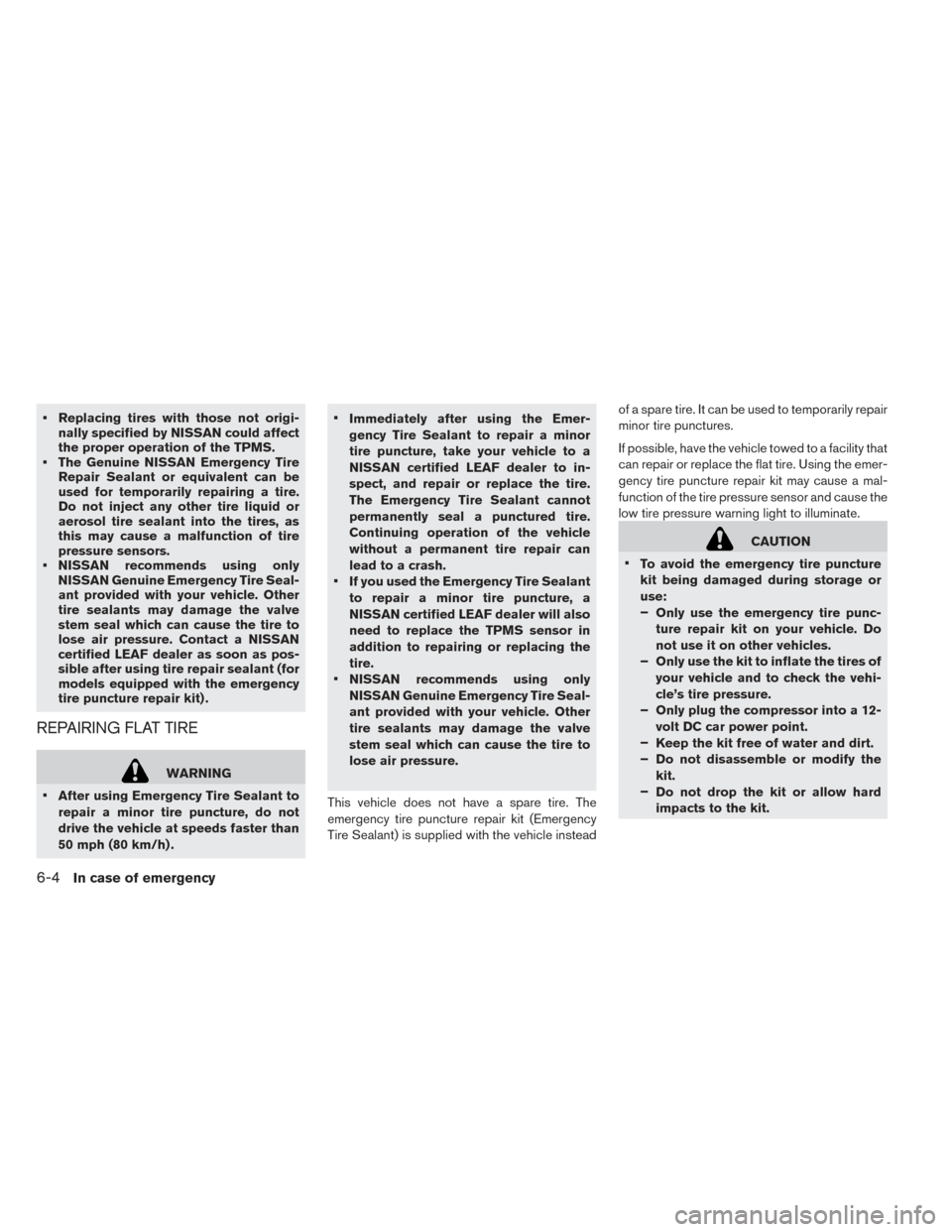
• Replacing tires with those not origi-nally specified by NISSAN could affect
the proper operation of the TPMS.
• The Genuine NISSAN Emergency Tire Repair Sealant or equivalent can be
used for temporarily repairing a tire.
Do not inject any other tire liquid or
aerosol tire sealant into the tires, as
this may cause a malfunction of tire
pressure sensors.
• NISSAN recommends using only NISSAN Genuine Emergency Tire Seal-
ant provided with your vehicle. Other
tire sealants may damage the valve
stem seal which can cause the tire to
lose air pressure. Contact a NISSAN
certified LEAF dealer as soon as pos-
sible after using tire repair sealant (for
models equipped with the emergency
tire puncture repair kit) .
REPAIRING FLAT TIRE
WARNING
• After using Emergency Tire Sealant to
repair a minor tire puncture, do not
drive the vehicle at speeds faster than
50 mph (80 km/h) . •
Immediately after using the Emer-
gency Tire Sealant to repair a minor
tire puncture, take your vehicle to a
NISSAN certified LEAF dealer to in-
spect, and repair or replace the tire.
The Emergency Tire Sealant cannot
permanently seal a punctured tire.
Continuing operation of the vehicle
without a permanent tire repair can
lead to a crash.
• If you used the Emergency Tire Sealant
to repair a minor tire puncture, a
NISSAN certified LEAF dealer will also
need to replace the TPMS sensor in
addition to repairing or replacing the
tire.
• NISSAN recommends using only
NISSAN Genuine Emergency Tire Seal-
ant provided with your vehicle. Other
tire sealants may damage the valve
stem seal which can cause the tire to
lose air pressure.
This vehicle does not have a spare tire. The
emergency tire puncture repair kit (Emergency
Tire Sealant) is supplied with the vehicle instead of a spare tire. It can be used to temporarily repair
minor tire punctures.
If possible, have the vehicle towed to a facility that
can repair or replace the flat tire. Using the emer-
gency tire puncture repair kit may cause a mal-
function of the tire pressure sensor and cause the
low tire pressure warning light to illuminate.
CAUTION
• To avoid the emergency tire puncture
kit being damaged during storage or
use:
–Only use the emergency tire punc-
ture repair kit on your vehicle. Do
not use it on other vehicles.
– Only use the kit to inflate the tires of
your vehicle and to check the vehi-
cle’s tire pressure.
– Only plug the compressor into a 12-
volt DC car power point.
– Keep the kit free of water and dirt.
– Do not disassemble or modify the
kit.
– Do not drop the kit or allow hard
impacts to the kit.
6-4In case of emergency
Page 335 of 437
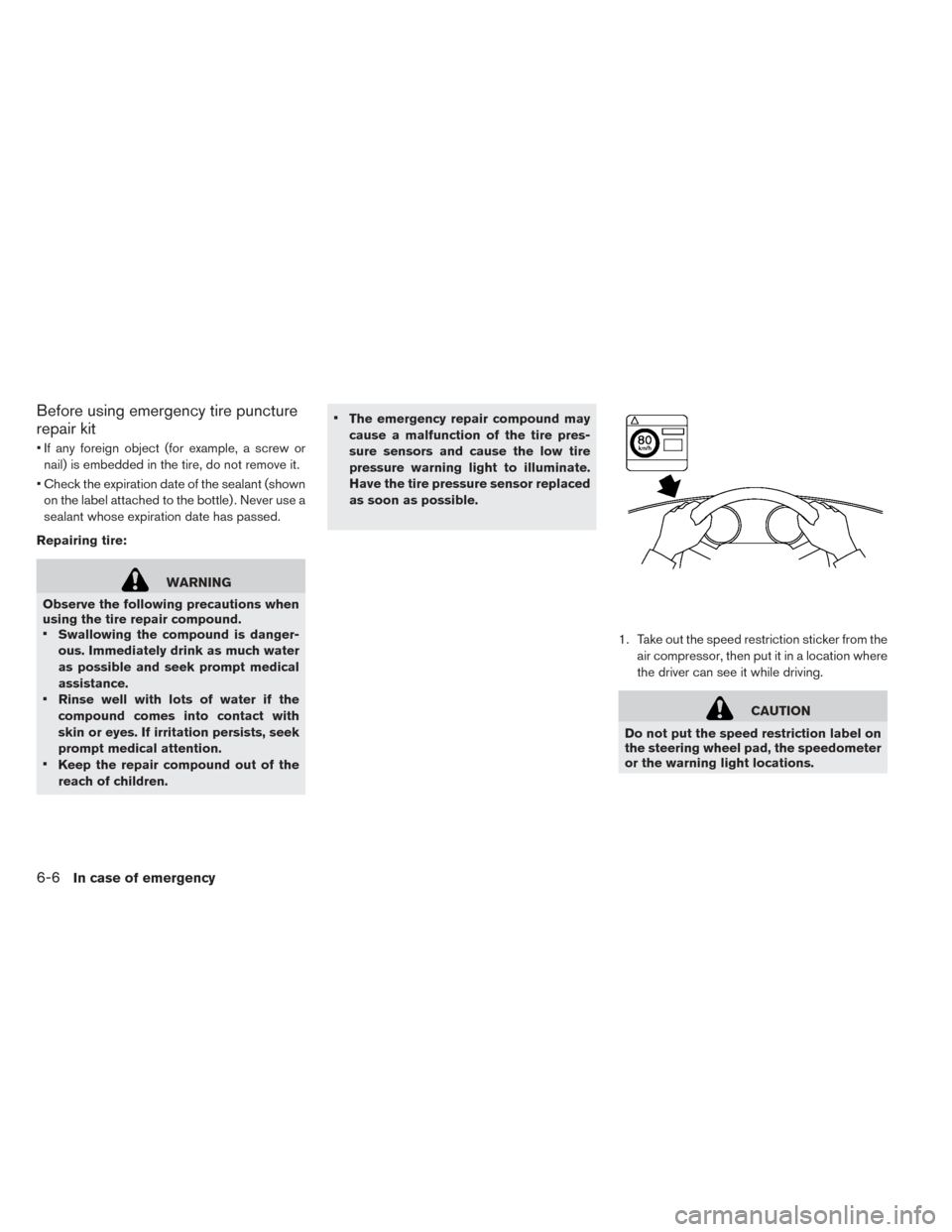
Before using emergency tire puncture
repair kit
• If any foreign object (for example, a screw ornail) is embedded in the tire, do not remove it.
• Check the expiration date of the sealant (shown on the label attached to the bottle) . Never use a
sealant whose expiration date has passed.
Repairing tire:
WARNING
Observe the following precautions when
using the tire repair compound.
• Swallowing the compound is danger-
ous. Immediately drink as much water
as possible and seek prompt medical
assistance.
• Rinse well with lots of water if the
compound comes into contact with
skin or eyes. If irritation persists, seek
prompt medical attention.
• Keep the repair compound out of the
reach of children. •
The emergency repair compound may
cause a malfunction of the tire pres-
sure sensors and cause the low tire
pressure warning light to illuminate.
Have the tire pressure sensor replaced
as soon as possible.
1. Take out the speed restriction sticker from theair compressor, then put it in a location where
the driver can see it while driving.
CAUTION
Do not put the speed restriction label on
the steering wheel pad, the speedometer
or the warning light locations.
6-6In case of emergency
Page 338 of 437
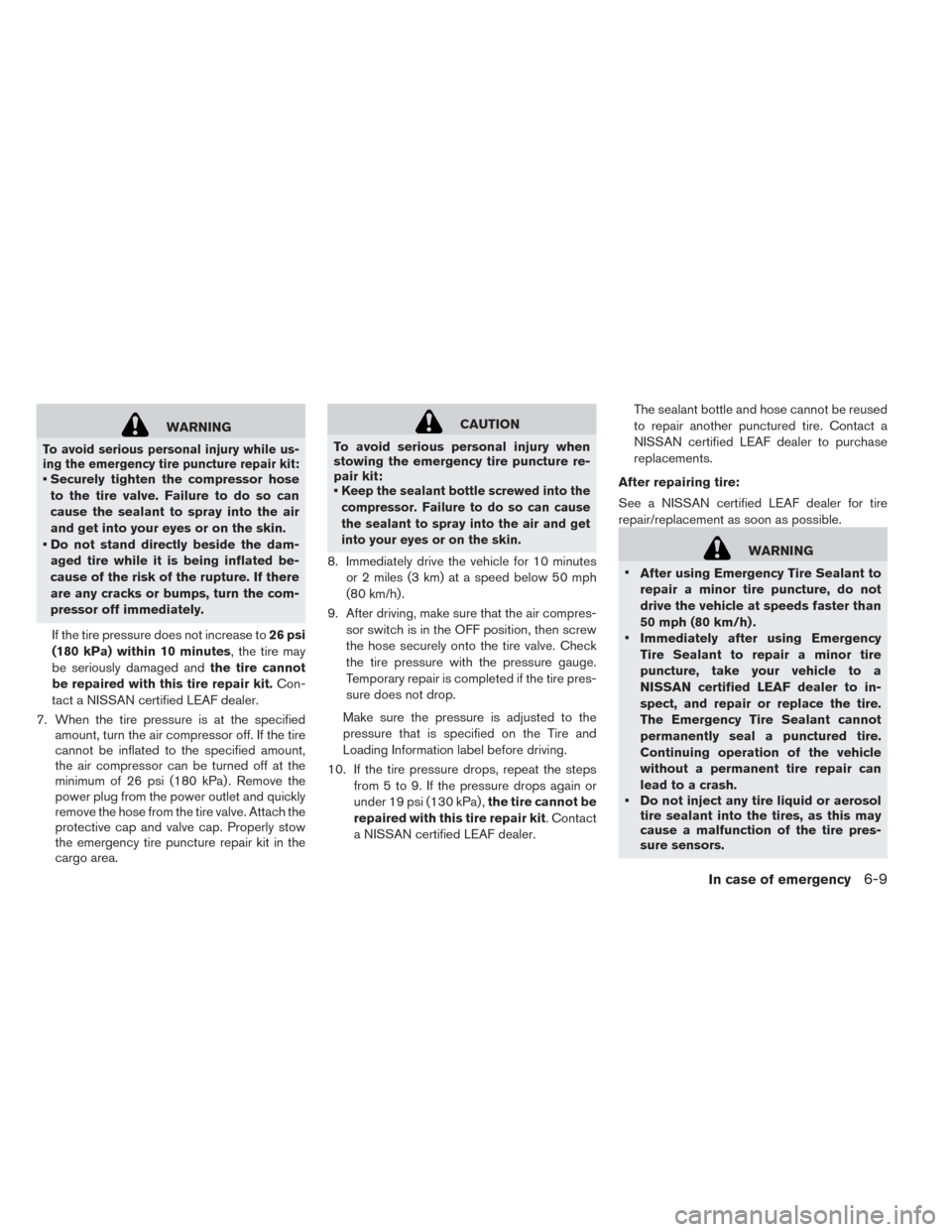
WARNING
To avoid serious personal injury while us-
ing the emergency tire puncture repair kit:
• Securely tighten the compressor hoseto the tire valve. Failure to do so can
cause the sealant to spray into the air
and get into your eyes or on the skin.
• Do not stand directly beside the dam- aged tire while it is being inflated be-
cause of the risk of the rupture. If there
are any cracks or bumps, turn the com-
pressor off immediately.
If the tire pressure does not increase to 26 psi
(180 kPa) within 10 minutes, the tire may
be seriously damaged and the tire cannot
be repaired with this tire repair kit. Con-
tact a NISSAN certified LEAF dealer.
7. When the tire pressure is at the specified amount, turn the air compressor off. If the tire
cannot be inflated to the specified amount,
the air compressor can be turned off at the
minimum of 26 psi (180 kPa) . Remove the
power plug from the power outlet and quickly
remove the hose from the tire valve. Attach the
protective cap and valve cap. Properly stow
the emergency tire puncture repair kit in the
cargo area.
CAUTION
To avoid serious personal injury when
stowing the emergency tire puncture re-
pair kit:
•
Keep the sealant bottle screwed into the
compressor. Failure to do so can cause
the sealant to spray into the air and get
into your eyes or on the skin.
8. Immediately drive the vehicle for 10 minutes or 2 miles (3 km) at a speed below 50 mph
(80 km/h) .
9. After driving, make sure that the air compres- sor switch is in the OFF position, then screw
the hose securely onto the tire valve. Check
the tire pressure with the pressure gauge.
Temporary repair is completed if the tire pres-
sure does not drop.
Make sure the pressure is adjusted to the
pressure that is specified on the Tire and
Loading Information label before driving.
10. If the tire pressure drops, repeat the steps from 5 to 9. If the pressure drops again or
under 19 psi (130 kPa) , the tire cannot be
repaired with this tire repair kit. Contact
a NISSAN certified LEAF dealer. The sealant bottle and hose cannot be reused
to repair another punctured tire. Contact a
NISSAN certified LEAF dealer to purchase
replacements.
After repairing tire:
See a NISSAN certified LEAF dealer for tire
repair/replacement as soon as possible.WARNING
• After using Emergency Tire Sealant to
repair a minor tire puncture, do not
drive the vehicle at speeds faster than
50 mph (80 km/h) .
• Immediately after using Emergency
Tire Sealant to repair a minor tire
puncture, take your vehicle to a
NISSAN certified LEAF dealer to in-
spect, and repair or replace the tire.
The Emergency Tire Sealant cannot
permanently seal a punctured tire.
Continuing operation of the vehicle
without a permanent tire repair can
lead to a crash.
• Do not inject any tire liquid or aerosol tire sealant into the tires, as this may
cause a malfunction of the tire pres-
sure sensors.
In case of emergency6-9
Page 339 of 437

• If you used the Emergency Tire Sealantto repair a minor tire puncture, a
NISSAN certified LEAF dealer will also
need to replace the TPMS sensor in
addition to repairing or replacing the
tire.
• NISSAN recommends using only NISSAN Genuine Emergency Tire Seal-
ant provided with your vehicle. Other
tire sealants may damage the valve
stem seal which can cause the tire to
lose air pressure. To start your EV system with a booster battery,
the instructions and precautions below must be
followed.
Jump starting provides power to the 12-volt sys-
tem to allow the electrical systems to operate.
The electrical systems must be operating to allow
the Li-ion battery to be charged. Jump starting
does not charge the Li-ion battery. The Li-ion
battery must be charged before the vehicle can
be driven.
WARNING
• If done incorrectly, jump starting can lead to a 12-volt battery explosion, re-
sulting in severe injury or death. It
could also damage your vehicle.
• Explosive hydrogen gas is always present in the vicinity of the 12-volt
battery. Keep all sparks and flames
away from the 12-volt battery.
• Do not allow battery fluid to come into contact with eyes, skin, clothing or
painted surfaces. Battery fluid is a cor-
rosive sulfuric acid solution that can
cause severe burns. If the fluid comes
into contact with anything, immedi-
ately flush the contacted area with wa-
ter. • Keep the 12-volt battery out of the
reach of children.
• The booster battery must be rated at 12 volt. Use of an improperly rated
battery can damage your vehicle.
• Whenever working on or near a 12-volt battery, always wear suitable eye pro-
tectors (for example, goggles or indus-
trial safety spectacles) and remove
rings, metal bands, or any other jew-
elry. Do not lean over the 12-volt bat-
tery when jump starting.
• Do not attempt to jump start a frozen battery. It could explode and cause se-
rious injury.
• Your vehicle has an automatic cooling fan. It could come on at any time. Keep
hands and other objects away from it.
JUMP STARTING
6-10In case of emergency
Page 349 of 437
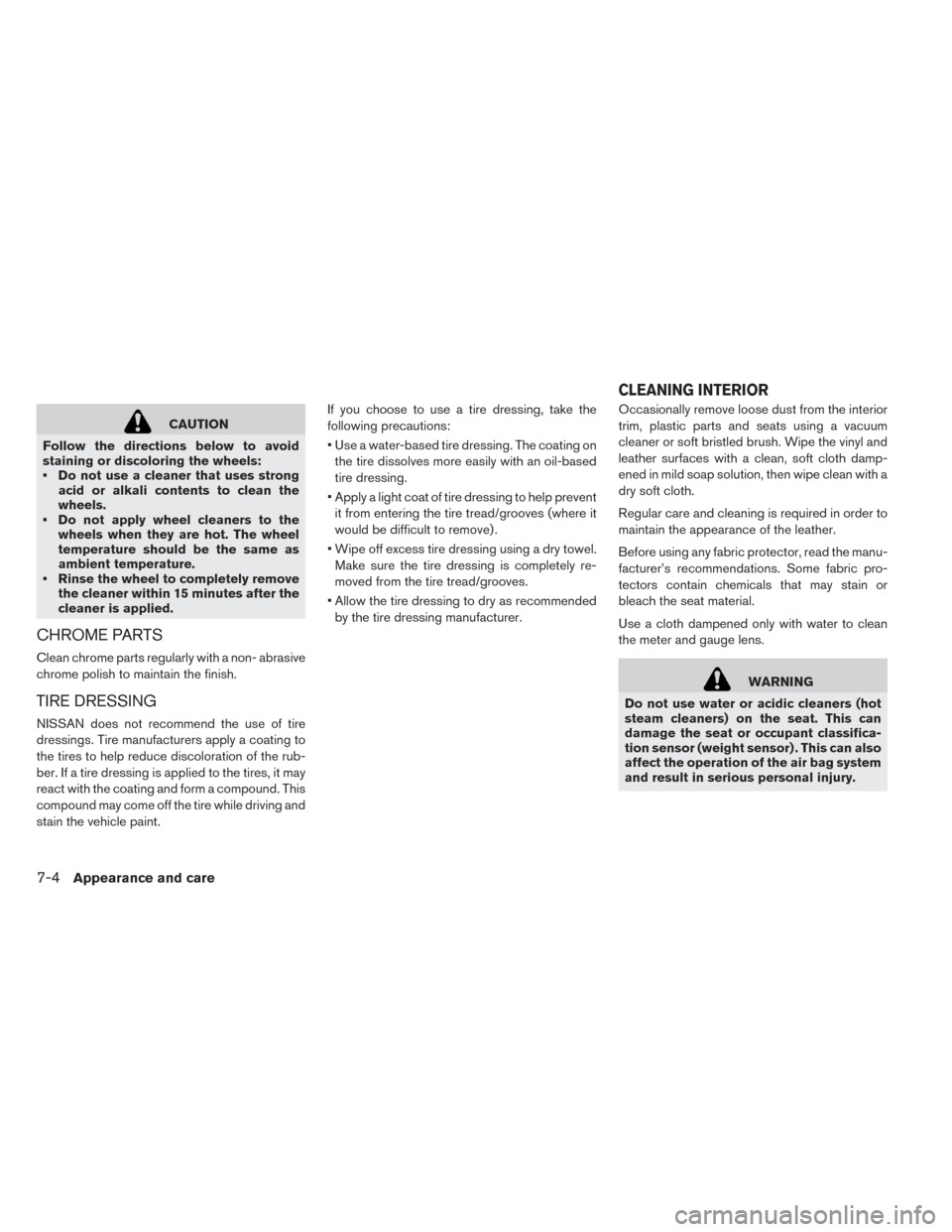
CAUTION
Follow the directions below to avoid
staining or discoloring the wheels:
• Do not use a cleaner that uses strong acid or alkali contents to clean the
wheels.
• Do not apply wheel cleaners to the wheels when they are hot. The wheel
temperature should be the same as
ambient temperature.
• Rinse the wheel to completely remove the cleaner within 15 minutes after the
cleaner is applied.
CHROME PARTS
Clean chrome parts regularly with a non- abrasive
chrome polish to maintain the finish.
TIRE DRESSING
NISSAN does not recommend the use of tire
dressings. Tire manufacturers apply a coating to
the tires to help reduce discoloration of the rub-
ber. If a tire dressing is applied to the tires, it may
react with the coating and form a compound. This
compound may come off the tire while driving and
stain the vehicle paint. If you choose to use a tire dressing, take the
following precautions:
• Use a water-based tire dressing. The coating on
the tire dissolves more easily with an oil-based
tire dressing.
• Apply a light coat of tire dressing to help prevent it from entering the tire tread/grooves (where it
would be difficult to remove) .
• Wipe off excess tire dressing using a dry towel. Make sure the tire dressing is completely re-
moved from the tire tread/grooves.
• Allow the tire dressing to dry as recommended by the tire dressing manufacturer. Occasionally remove loose dust from the interior
trim, plastic parts and seats using a vacuum
cleaner or soft bristled brush. Wipe the vinyl and
leather surfaces with a clean, soft cloth damp-
ened in mild soap solution, then wipe clean with a
dry soft cloth.
Regular care and cleaning is required in order to
maintain the appearance of the leather.
Before using any fabric protector, read the manu-
facturer’s recommendations. Some fabric pro-
tectors contain chemicals that may stain or
bleach the seat material.
Use a cloth dampened only with water to clean
the meter and gauge lens.
WARNING
Do not use water or acidic cleaners (hot
steam cleaners) on the seat. This can
damage the seat or occupant classifica-
tion sensor (weight sensor) . This can also
affect the operation of the air bag system
and result in serious personal injury.
CLEANING INTERIOR
7-4Appearance and care
Page 389 of 437
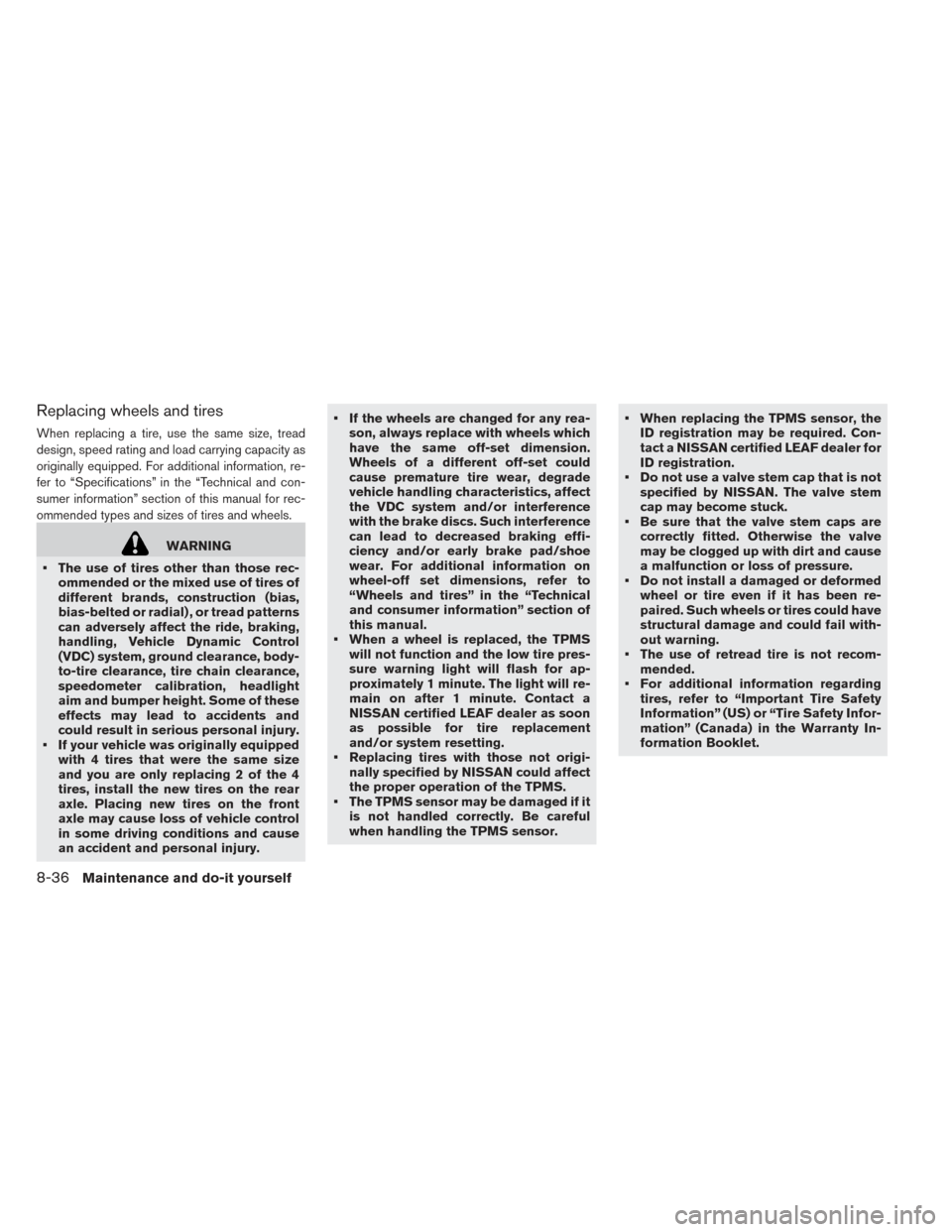
Replacing wheels and tires
When replacing a tire, use the same size, tread
design, speed rating and load carrying capacity as
originally equipped. For additional information, re-
fer to “Specifications” in the “Technical and con-
sumer information” section of this manual for rec-
ommended types and sizes of tires and wheels.
WARNING
• The use of tires other than those rec- ommended or the mixed use of tires of
different brands, construction (bias,
bias-belted or radial) , or tread patterns
can adversely affect the ride, braking,
handling, Vehicle Dynamic Control
(VDC) system, ground clearance, body-
to-tire clearance, tire chain clearance,
speedometer calibration, headlight
aim and bumper height. Some of these
effects may lead to accidents and
could result in serious personal injury.
• If your vehicle was originally equipped with 4 tires that were the same size
and you are only replacing 2 of the 4
tires, install the new tires on the rear
axle. Placing new tires on the front
axle may cause loss of vehicle control
in some driving conditions and cause
an accident and personal injury. • If the wheels are changed for any rea-
son, always replace with wheels which
have the same off-set dimension.
Wheels of a different off-set could
cause premature tire wear, degrade
vehicle handling characteristics, affect
the VDC system and/or interference
with the brake discs. Such interference
can lead to decreased braking effi-
ciency and/or early brake pad/shoe
wear. For additional information on
wheel-off set dimensions, refer to
“Wheels and tires” in the “Technical
and consumer information” section of
this manual.
• When a wheel is replaced, the TPMS will not function and the low tire pres-
sure warning light will flash for ap-
proximately 1 minute. The light will re-
main on after 1 minute. Contact a
NISSAN certified LEAF dealer as soon
as possible for tire replacement
and/or system resetting.
• Replacing tires with those not origi- nally specified by NISSAN could affect
the proper operation of the TPMS.
• The TPMS sensor may be damaged if it is not handled correctly. Be careful
when handling the TPMS sensor. • When replacing the TPMS sensor, the
ID registration may be required. Con-
tact a NISSAN certified LEAF dealer for
ID registration.
• Do not use a valve stem cap that is not specified by NISSAN. The valve stem
cap may become stuck.
• Be sure that the valve stem caps are correctly fitted. Otherwise the valve
may be clogged up with dirt and cause
a malfunction or loss of pressure.
• Do not install a damaged or deformed wheel or tire even if it has been re-
paired. Such wheels or tires could have
structural damage and could fail with-
out warning.
• The use of retread tire is not recom- mended.
• For additional information regarding tires, refer to “Important Tire Safety
Information” (US) or “Tire Safety Infor-
mation” (Canada) in the Warranty In-
formation Booklet.
8-36Maintenance and do-it yourself